Business
UK inflation: What is the rate and why are prices still rising?
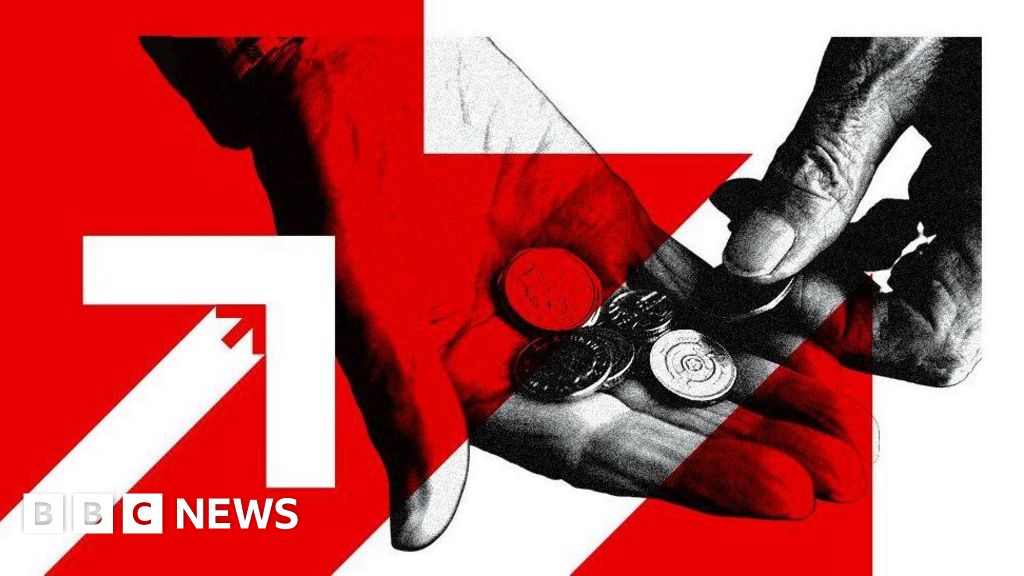
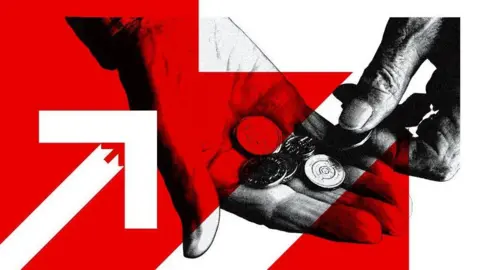 BBC
BBCPrices in the UK rose by 3.8% in the 12 months to July, driven by higher air fares, as well as increases in the cost of food.
It means inflation remains above the Bank of England’s 2% target.
The Bank moves interest rates up and down to try to keep inflation at that level, and has cut interest rates five times since August 2024.
What is inflation?
Inflation is the increase in the price of something over time.
For example, if a bottle of milk costs £1 but is £1.05 a year later, then annual milk inflation is 5%.
How is the UK’s inflation rate measured?
The prices of hundreds of everyday items, including food and fuel, are tracked by the Office for National Statistics (ONS).
This virtual “basket of goods” is regularly updated to reflect shopping trends, with virtual reality headsets and yoga mats added in 2025, and local newspaper adverts removed.
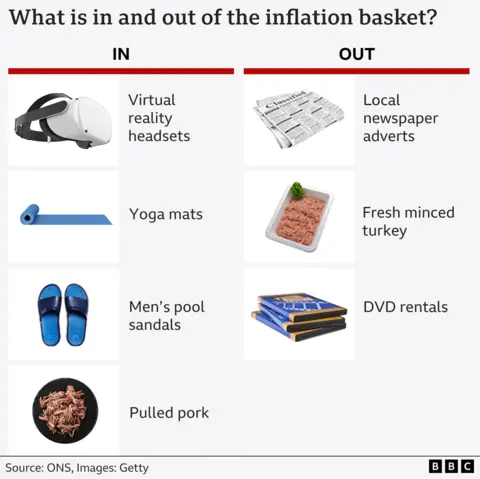
The ONS monitors price changes over the previous 12 months to calculate inflation.
The main inflation measure is called the Consumer Prices Index (CPI), and the latest figure is published every month.
CPI was 3.8% in the year to July 2025, up from 3.6% in the 12 months to June. The July 2025 figure is the highest recorded since January 2024, when the rate was 4.0%.
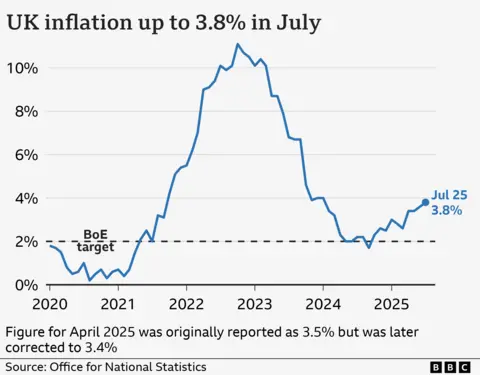
The Bank also considers other measures such as “core inflation” when deciding whether and how to change rates.
This doesn’t include food or energy prices because they tend to be very volatile, so can be a better indication of longer term trends.
Core CPI was 3.8% in the 12 months to July, up slightly from 3.7% recorded in the year to June.
Why are prices still rising?
Inflation has fallen significantly since hitting 11.1% in October 2022, which was the highest rate for 40 years.
But that doesn’t mean prices are falling – just that they are rising less quickly.
Inflation soared in 2022 because oil and gas were in greater demand after the Covid pandemic, and energy prices surged again when Russia invaded Ukraine.
It then remained well above the 2% target partly because of higher food prices.
These continue to be a significant factor in the current inflation figures.
Inflation for food and non-alcoholic beverages was 4.9% in the year to July, up from 4.5% in the year to June.
Beef, sugar, chocolate, instant coffee and fruit juice saw significant price rises.
But the main factor driving the July inflation figure was higher air fares, which saw the largest July increase since the ONS began collecting that data on a monthly basis in 2001.
In addition, fuel prices fell only slightly between May and June 2025, compared to a larger drop in the same period in 2024.
Why does putting up interest rates help to lower inflation?
When inflation was well above its 2% target, the Bank of England increased interest rates to 5.25%, a 16-year high.
The idea is that if you make borrowing more expensive, people have less money to spend. People may also be encouraged to save more.
In turn, this reduces demand for goods and slows price rises.
But it is a balancing act – increasing borrowing costs risks harming the economy.
For example, homeowners face higher mortgage repayments, which can outweigh better savings deals.
Businesses also borrow less, making them less likely to create jobs. Some may cut staff and reduce investment.
In recent months inflation has remained above the Bank’s target at the same time as the economy has remained relatively flat and the jobs market has softened.
Therefore, the Bank has chosen to cut rates, despite high inflation, in an attempt to encourage people to spend more and get businesses to invest and create jobs to boost the economy.
What is happening to UK interest rates and when will they go down again?
The Bank of England began cutting rates in August 2024, and made five cuts to bring the rate down to 4%.
Bank of England governor Andrew Bailey had said that future cuts will be made gradually and carefully.
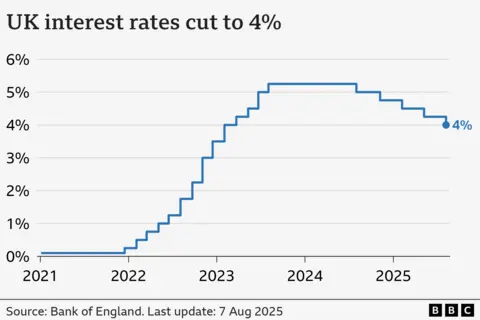
The August interest rate decision was extremely close, with the committee voting 5-4 to cut rates by a quarter percentage point.
It followed an unprecedented second vote by the Bank’s policymakers, as one economist wanted a larger cut of half a percentage point.
This suggests future interest rate decisions could also be finely balanced.
Inflation is now expected to peak at 4% in September, the Bank said in its latest Monetary Policy Report. That is twice the Bank’s target rate and above the 3.8% high it predicted in its previous report in May.
A further interest rate cut had been expected at the Bank’s meeting in November, but analysts are now less sure this will happen given the closeness of the August vote.
The Bank also has to consider the wider global economy. Mr Bailey has repeatedly warned about the unpredictable impact of US tariffs, and conflict in Israel and Iran has also created uncertainty.
Are wages keeping up with inflation?
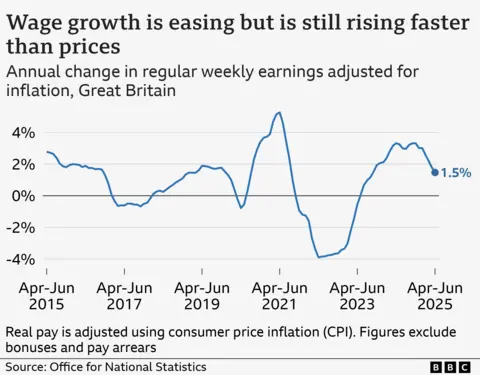
Annual average regular earnings growth was 5.7% for the public sector and 4.8% for the private sector.
Meanwhile, separate ONS figures showed the number of vacancies fell again to 718,000 for the May to July period, marking three continuous years of falling job openings.
The unemployment rate was 4.7% in the three months to July – the same as the three months to April.
This marked the highest level of unemployment since June 2021, and is also likely to factor into the Bank of England’s decision whether to cut rates again.
What is happening to inflation and interest rates in Europe and the US?
The US and EU countries have also been trying to limit price increases.
The inflation rate for countries using the euro was 2.1% in August, according to an early estimate.
In June 2024, the European Central Bank (ECB) cut its main interest rate from an all-time high of 4% to 3.75%, the first fall in five years.
By July 2025, after several further cuts, its key rate stood at 2%.
Inflation in the US held steady at 2.7% in July, remaining above the US central bank’s 2% target.
After a string of cuts in the latter part of 2024, the US central bank again chose not to change rates at its July 2025 meeting, the fifth hold in a row.
That leaves its key interest rate unchanged in a range of 4.25% to 4.5%.
The Federal Reserve has repeatedly come under attack from President Trump, who wants to see further interest rate cuts.
Business
How To Apply For Insurance Claim After Accident? Where Does Licence Validity Come In? | Explained

Last Updated:
Even if your driving licence has expired, the law protects accident victims. Learn how insurance claims work and what the 30-day grace period covers
The rules for insurance claims following a road accident differ depending on whether it is a third-party claim or an own damage claim.
The Punjab and Haryana High Court has clarified that a driving licence remains valid for 30 days after its expiry. If an accident occurs on the 30th and final day of this grace period, the insurance company is legally required to honour the claim.
According to The Tribune, the licence in the case under consideration expired on June 4, 2001. The 30-day grace period began on June 5, meaning the licence remained valid until July 4, 2001. The accident took place on July 4, 2001, at around 10:45 am, and as it fell within the grace period, the licence was deemed legally valid.
Insurance Claims In India: What The Law Says
The rules for insurance claims following a road accident differ depending on whether it is a third-party claim or an own damage claim.
Third-Party Insurance: Mandatory for All Vehicles
Under Section 146 of the Motor Vehicles Act, 1988, third-party insurance is compulsory for every vehicle in India. Third-party claims relate to:
- Injury or death of a third party
- Damage to third-party property
The Supreme Court has consistently ruled that even if the driver has no licence, an expired licence, a suspended licence or a licence of the wrong category, the insurance company must still compensate the victim or their family.
This obligation remains even if:
- The driver has no driving licence at all
- The licence has expired
- The licence is suspended
- The licence belongs to an incorrect vehicle category
- The driver only holds a learner’s licence
‘Pay and Recover’ Principle
The Supreme Court frequently applies the pay and recover principle:
- The insurer must first pay compensation to the victim.
- The insurer may then recover the amount from the vehicle owner.
In 2023, the Supreme Court reaffirmed that the victim must not suffer because the driver lacked a valid licence.
Own Damage Claims: Strict Rules Apply
The rules for own damage claims are entirely different. Every motor insurance policy clearly states that the driver must have:
- A valid driving licence
- A proper licence for the vehicle category
If, at the time of the accident:
- The driver had no licence, or
- The licence had expired, or
- The licence was not appropriate for that vehicle,
the insurance company will reject the own damage claim entirely.
This position was upheld by the Supreme Court in Dharmendra Goyal vs Reliance General Insurance (2022) and reaffirmed in multiple judgements between 2023 and 2025.
The National Consumer Commission (NCDRC) issued similar rulings in dozens of cases.
Grace Period And Licence Validity
If an accident occurs within the 30-day grace period after the licence has expired, insurance policies provide full coverage, both for:
- Third-party claims, and
- Own damage claims
This rule is applicable nationwide.
When Is Renewal Necessary?
According to Section 15 of the Motor Vehicles Act, 1988 and the Central Motor Vehicles Rules, 1989:
30-Day Grace Period
- The licence remains fully valid for 30 days after expiry.
- There is no penalty if renewed within these 30 days.
Penalties After The Grace Period
- After 30 days: Rs 300 fine, increasing to Rs 1,000 per year.
- After 1 year: The applicant must take the driving test again.
- After 5 years: A complete restart is required, including a new learner’s licence.
Renewal Made Easier (2025 Guidelines)
The Ministry of Transport’s 2025 guidelines confirm:
- The 30-day grace period applies across India.
- Driving licences can be renewed instantly online via the Parivahan.gov.in portal.
December 08, 2025, 14:12 IST
Read More
Business
IndiGo Shares Sink Over 6.5% Amid Ongoing Flight Disruptions

Mumbai: Shares of InterGlobe Aviation, the parent company of IndiGo Airlines, fell sharply in early trade on Monday, dropping 6.6 per cent to an intra-day low of Rs 5,015 on the BSE.
However, it recovered later as around 9:45 a.m., the shares were trading at Rs 5,159.50, down by Rs 211 or 3.93 per cent.
The sell-off came after the Directorate General of Civil Aviation (DGCA) extended the deadline for IndiGo CEO Pieter Elbers to respond to a show-cause notice linked to the airline’s recent operational disruptions.
The aviation regulator had issued a show-cause notice to IndiGo’s accountable manager on Sunday, just a day after sending a similar notice to CEO Pieter Elbers.
The DGCA said that the airline’s massive wave of cancellations over the past week caused widespread inconvenience and distress to passengers across the country.
According to the regulator, the disruptions were largely triggered by IndiGo’s failure to plan properly for the rollout of the revised Flight Duty Time Limitations (FDTL) rules.
These rules, which lay down the duty hours and mandatory rest periods for flight crew, came into effect recently and have created significant operational challenges for the airline.
In its notice, the DGCA pointed out that IndiGo’s “large-scale operation failures” suggest major lapses in planning, oversight and resource management.
The accountable manager has been given 24 hours to explain why enforcement action should not be taken. If the airline fails to respond within the extended deadline, the DGCA has said it will proceed based on the information available.
Even as the regulatory pressure increases, IndiGo said on Sunday that it has restored 95 per cent of its network and plans to operate around 1,500 flights.
The airline claimed that its operations are on track to stabilise by December 10, with improving on-time performance and fewer cancellations.
However, more than 220 flights had already been cancelled across major airports by the time of reporting, adding to the inconvenience faced by thousands of passengers.
Business
Trump raises potential concerns over $72bn Netflix-Warner Bros deal

US President Donald Trump has flagged potential concerns over Netflix’s planned $72bn (£54bn) deal to buy Warner Brothers Discovery’s movie studio and popular HBO streaming networks.
At an event in Washington DC on Sunday, he said Netflix has a “big market share” and the firms’ combined size “could be a problem”.
On Friday, the two companies said they had reached an agreement that could bring Warner Brothers’ franchises like Harry Potter and Game of Thrones to Netflix, creating a new media giant.
The planned deal, which has raised concerns among some in the industry, is yet to be approved by competition authorities. The BBC has contacted Warner Brothers, Netflix and the White House for comment.
Launched in 1997 as a postal DVD rental business, Netflix has grown to become the world’s largest subscription streaming service. The deal – the biggest the film industry has seen in a long time – would cement its number one position.
Under the agreement several global entertainment franchises, such as Looney Tunes, The Matrix and Lord of the Rings, would move to Netflix.
The US Justice Department’s competition division, which oversees major mergers, could contend that the deal violates the law if the combined businesses account for too much of the streaming market.
At an event at the John F. Kennedy Center in the US capital, Trump said that Netflix has a “very big market share” which would “go up by a lot” if the deal goes ahead.
Trump added that he would be personally involved in the decision on whether or not to approve the deal and repeatedly highlighted the size of Netflix’s market share.
He also said that Netflix’s co-CEO Ted Sarandos recently visited the Oval Office and praised him for his work at the company.
“I have a lot of respect for him. He’s a great person,” said Trump. “He’s done one of the greatest jobs in the history of movies.”
Mr Sarandos earlier acknowledged that the agreement may have surprised investors but said it was a chance to position Netflix for success in the “decades to come”.
Some in the entertainment industry have criticised the agreement.
The Writers Guild of America’s East and West branches called for the merger to be blocked, saying the “world’s largest streaming company swallowing one of its biggest competitors is what antitrust laws were designed to prevent.”
“The outcome would eliminate jobs, push down wages, worsen conditions for all entertainment workers, raise prices for consumers and reduce the volume and diversity of content for all viewers,” it said on Friday.
-

 Tech1 week ago
Tech1 week agoGet Your Steps In From Your Home Office With This Walking Pad—On Sale This Week
-

 Sports1 week ago
Sports1 week agoIndia Triumphs Over South Africa in First ODI Thanks to Kohli’s Heroics – SUCH TV
-

 Entertainment1 week ago
Entertainment1 week agoSadie Sink talks about the future of Max in ‘Stranger Things’
-

 Fashion1 week ago
Fashion1 week agoResults are in: US Black Friday store visits down, e-visits up, apparel shines
-

 Politics1 week ago
Politics1 week agoElon Musk reveals partner’s half-Indian roots, son’s middle name ‘Sekhar’
-

 Tech1 week ago
Tech1 week agoPrague’s City Center Sparkles, Buzzes, and Burns at the Signal Festival
-

 Sports1 week ago
Sports1 week agoBroncos secure thrilling OT victory over Commanders behind clutch performances
-

 Entertainment1 week ago
Entertainment1 week agoNatalia Dyer explains Nancy Wheeler’s key blunder in Stranger Things 5






